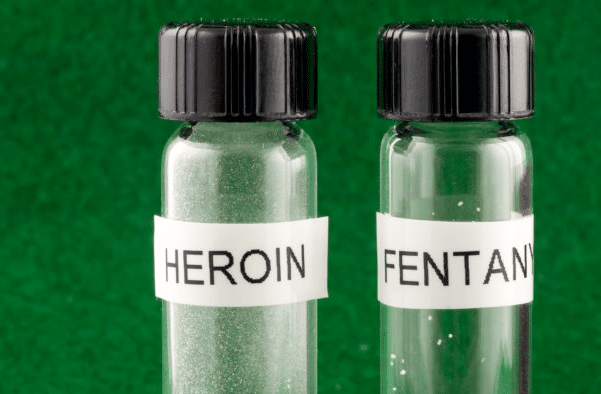
Heroin and fentanyl abuse have become one of the most pressing public health crises of the 21st century, particularly in North America. These potent substances are responsible for a significant number of overdose deaths each year, devastating families, communities, and individuals. Heroin, an illicit opioid derived from morphine, has long been a substance of abuse, but the introduction of fentanyl, a synthetic opioid that is exponentially stronger than heroin, has exacerbated the crisis to unprecedented levels.
Both heroin and fentanyl are highly addictive, and their abuse is a complex issue involving social, psychological, and physical factors. While they may originate from different sources—heroin as an illicit street drug and fentanyl as a prescription medication with illicit manufacturing routes—they both wreak havoc on the lives of those who misuse them. In this article, we will explore the characteristics, causes, risk factors, signs, symptoms, consequences, and treatment options related to heroin and fentanyl abuse.
What are Heroin and Fentanyl?
Heroin
Heroin is an illegal opioid that is derived from morphine, a natural substance obtained from the seed pod of the opium poppy plant. It is a powerful central nervous system depressant that induces feelings of intense euphoria, relaxation, and pain relief. Heroin can be injected, smoked, or snorted, and its effects are felt almost immediately after use.
When heroin enters the body, it is rapidly converted into morphine, which then binds to opioid receptors in the brain and spinal cord, causing pain relief, sedation, and a surge of pleasure. However, repeated use of heroin leads to tolerance, meaning users must consume larger quantities to achieve the same effect, increasing the risk of overdose and addiction.
Fentanyl
Fentanyl is a synthetic opioid that is 50 to 100 times stronger than morphine and up to 50 times more potent than heroin. It is used medically to treat severe pain, particularly in cancer patients or those recovering from surgery, often in the form of patches, lozenges, or injectable forms. However, fentanyl is also manufactured illicitly and mixed with other substances, including heroin, cocaine, and counterfeit prescription pills, which significantly increases the risk of overdose.
Illegally produced fentanyl is often found in powder form or pressed into pill-like tablets, mimicking other drugs such as oxycodone or alprazolam. Since fentanyl is so potent, even a small amount can lead to a fatal overdose, especially if individuals are unaware that the drug has been added to their substance of abuse.
Call Now – Your Journey to Recovery Begins Today!

Take the first step towards a healthier life! Call now to connect with our compassionate team and start your recovery journey today. Your path to healing awaits!
Our recovery specialists are available 24/7 to provide support, and all calls are confidential and free. Reach out anytime – we’re here to help!
The Epidemic of Heroin and Fentanyl Abuse
Heroin Abuse and Its Rise
The abuse of heroin has been a public health issue for decades, but its prevalence significantly increased in the 2000s. Heroin’s rise in popularity is closely tied to the opioid epidemic, as many individuals who were first prescribed prescription painkillers like oxycodone and hydrocodone turned to heroin after their prescriptions ran out or became more difficult to obtain. Heroin is often cheaper and more accessible than prescription opioids, making it a common choice for those struggling with opioid dependence.
Heroin abuse is particularly concerning due to its rapid onset of effects and the intense euphoric feelings it produces. However, repeated heroin use leads to a high risk of addiction, physical dependence, and overdose. The shift from prescription opioids to heroin use has significantly contributed to the opioid crisis, with heroin overdoses accounting for a large proportion of opioid-related deaths.
The Role of Fentanyl in the Crisis
While heroin abuse remains a significant problem, fentanyl has become a central player in the opioid epidemic. Fentanyl’s role in the crisis has escalated in recent years, particularly as illicit fentanyl has flooded the black market. It is frequently mixed with heroin or sold as counterfeit pills, often without the user’s knowledge. This dangerous practice increases the risk of overdose exponentially, as individuals may unknowingly consume a potent dose of fentanyl.
According to the National Institute on Drug Abuse (NIDA), fentanyl and its analogs were involved in nearly 60% of opioid overdose deaths in 2020. The increasing presence of fentanyl has made it more difficult for public health agencies to address the opioid crisis, as even those who are familiar with heroin may unknowingly consume a lethal dose of fentanyl, which can cause respiratory failure within minutes.
Risk Factors for Heroin and Fentanyl Abuse
Several factors contribute to the risk of heroin and fentanyl abuse. These include biological, psychological, and environmental factors that make some individuals more susceptible to addiction.
Biological Factors
Genetics plays a significant role in the likelihood of developing an addiction to heroin or fentanyl. Individuals with a family history of addiction may be at a higher risk of developing substance use disorders. Additionally, people who experience chronic pain, especially those with conditions like fibromyalgia, arthritis, or back pain, are more likely to use opioids, which can increase the risk of transitioning from prescription medications to illicit drugs like heroin.
Psychological Factors
Mental health conditions such as depression, anxiety, post-traumatic stress disorder (PTSD), and bipolar disorder are strongly linked to substance abuse, including heroin and fentanyl. Individuals who struggle with mental health issues may turn to opioids as a form of self-medication to numb emotional pain or escape from stressful situations. The euphoria produced by opioids can temporarily alleviate feelings of sadness, fear, or hopelessness, leading to continued use and, eventually, addiction.
Environmental Factors
Environmental influences, such as peer pressure, family history of substance abuse, and exposure to drug use in one’s community, also contribute to the risk of heroin and fentanyl abuse. Adolescents and young adults are particularly vulnerable to experimenting with drugs in social settings, and the availability of heroin and fentanyl in some areas increases the likelihood of misuse.
Economic factors, including unemployment, poverty, and lack of access to healthcare, also play a role. People who face financial difficulties or live in underserved communities may turn to substance use as a coping mechanism, and the high availability of illicit drugs like heroin and fentanyl in certain regions exacerbates this issue.
Call Now – Your Journey to Recovery Begins Today!

Take the first step towards a healthier life! Call now to connect with our compassionate team and start your recovery journey today. Your path to healing awaits!
Our recovery specialists are available 24/7 to provide support, and all calls are confidential and free. Reach out anytime – we’re here to help!
Signs and Symptoms of Heroin and Fentanyl Abuse
Recognizing the signs of heroin and fentanyl abuse is critical for early intervention. Both drugs produce similar effects, but there are some distinctions between the two.
Heroin Abuse Symptoms
- Euphoria and sedation: The primary effect of heroin use is an intense feeling of euphoria, followed by drowsiness or sedation.
- Pinpoint pupils: A telltale sign of opioid use, including heroin, is constricted or “pinpoint” pupils.
- Respiratory depression: Heroin slows down the respiratory system, which can be life-threatening in overdose situations.
- Track marks: Injection drug users may have visible needle marks on their arms or legs, which can indicate heroin use.
- Mood swings and behavioral changes: Heroin abuse often leads to erratic behavior, mood swings, and social withdrawal.
Fentanyl Abuse Symptoms
- Nausea and vomiting: Fentanyl can cause significant gastrointestinal distress, including nausea, vomiting, and constipation.
- Drowsiness and confusion: Fentanyl can induce intense drowsiness and confusion, which can make individuals appear overly sedated.
- Difficulty breathing: One of the most dangerous effects of fentanyl is respiratory depression, which can result in slow or stopped breathing, often leading to overdose.
- Slurred speech and impaired coordination: Like heroin, fentanyl use impairs motor skills and speech, making it difficult to communicate or move properly.
Overdose Symptoms
Overdose from heroin or fentanyl can be fatal, and the symptoms are often similar:
- Severe drowsiness or inability to wake up
- Slow or stopped breathing
- Blue or purple lips or fingertips
- Unconsciousness
- Low blood pressure and weak pulse
If you suspect someone has overdosed on heroin or fentanyl, it is essential to seek immediate medical attention. Naloxone, an opioid antagonist, can reverse the effects of an overdose if administered quickly.
Consequences of Heroin and Fentanyl Abuse
The abuse of heroin and fentanyl has devastating consequences, both physically and socially. These drugs can lead to long-term health complications and disrupt every aspect of an individual’s life.
Physical Health Risks
- Infectious diseases: People who inject heroin or fentanyl are at risk for HIV, hepatitis C, and other bloodborne infections due to needle sharing.
- Overdose and death: The most immediate risk of heroin and fentanyl abuse is overdose, which can lead to death if not treated promptly.
- Organ damage: Long-term opioid abuse can lead to damage to the liver, kidneys, and other organs due to the toxic effects of the drugs.
- Respiratory problems: Both heroin and fentanyl can cause severe respiratory depression, leading to breathing difficulties and long-term lung damage.
Social and Legal Consequences
Heroin and fentanyl abuse also comes with significant social and legal consequences. People struggling with addiction may face legal problems, such as arrest or incarceration, especially if they are involved in drug trafficking or obtain the drugs illegally. Addiction can also strain relationships with family and friends, causing social isolation, loss of employment, and financial hardship.
Treatment Options for Heroin and Fentanyl Abuse
Fortunately, there are several treatment options available for individuals struggling with heroin and fentanyl abuse. Effective treatment often requires a combination of medical intervention, behavioral therapy, and ongoing support.
Medication-Assisted Treatment (MAT)
MAT is a highly effective treatment for opioid use disorders, including heroin and fentanyl addiction. Medications such as methadone, buprenorphine, and naltrexone are used to reduce cravings, manage withdrawal symptoms, and block the effects of opioids. MAT is often combined with counseling and therapy to address the psychological aspects of addiction.
Detoxification
For individuals with severe addiction, detoxification is often the first step in treatment. Detox involves the supervised removal of the drug from the body and the management of withdrawal symptoms. While detox alone is not a complete solution, it is a crucial first step in preparing for further rehabilitation.
Behavioral Therapy and Counseling
Behavioral therapies such as Cognitive Behavioral Therapy (CBT) and Contingency Management help individuals identify and change the behaviors associated with drug use. Therapy can also help individuals address any underlying mental health conditions, such as anxiety or depression, that may contribute to their addiction.
Call Now – Your Journey to Recovery Begins Today!

Take the first step towards a healthier life! Call now to connect with our compassionate team and start your recovery journey today. Your path to healing awaits!
Our recovery specialists are available 24/7 to provide support, and all calls are confidential and free. Reach out anytime – we’re here to help!
Inpatient and Outpatient Rehabilitation
Inpatient rehab programs provide intensive care in a residential setting, offering 24/7 support and treatment. Outpatient programs allow individuals to live at home while attending treatment sessions during the week. Both inpatient and outpatient rehab programs are designed to help individuals develop the skills needed for long-term recovery.
Support Groups
Support groups like Narcotics Anonymous (NA) provide a sense of community for individuals in recovery. Sharing experiences with others who are facing similar struggles can help individuals maintain their sobriety and offer emotional support throughout the recovery process.
Final Thoughts
Heroin and fentanyl abuse continues to wreak havoc on individuals and communities worldwide. These powerful opioids are highly addictive and present significant risks, including overdose and death. However, with the right treatment and support, recovery is possible.
By seeking help early and utilizing medication-assisted treatment, behavioral therapy, and rehabilitation, individuals can break free from the grip of addiction and rebuild their lives.
If you or someone you know is struggling with heroin or fentanyl abuse, it is critical to reach out to a healthcare provider or addiction specialist. Help is available, and recovery is within reach.
What is the difference between heroin and fentanyl?
Heroin is an illicit opioid derived from morphine, typically obtained from the opium poppy plant. It is usually smoked, snorted, or injected. Fentanyl, on the other hand, is a synthetic opioid that is 50 to 100 times stronger than morphine and is often prescribed for severe pain. However, illicit fentanyl is frequently mixed with other substances like heroin or pressed into counterfeit pills, making it much more dangerous.
How can you tell if someone is using heroin or fentanyl?
Signs of heroin or fentanyl abuse include euphoria, drowsiness, pinpoint pupils, slurred speech, confusion, and respiratory depression (slow or difficulty breathing). Users may also experience a loss of coordination and mood swings. In the case of fentanyl, users may also display symptoms like nausea, vomiting, and extreme sedation.
What are the risks of using heroin or fentanyl?
The most significant risks associated with heroin and fentanyl use include overdose, which can lead to respiratory failure and death. Both drugs have a high potential for addiction, and long-term abuse can result in physical dependence, liver and kidney damage, and impaired cognitive function. The presence of fentanyl in street drugs significantly increases the risk of overdose, even for individuals who are experienced drug users.
Can someone recover from heroin or fentanyl addiction?
Yes, recovery from heroin and fentanyl addiction is possible with the right treatment and support. Medication-assisted treatment (MAT), which includes medications like methadone, buprenorphine, and naltrexone, can help manage cravings and withdrawal symptoms. Behavioral therapies, such as Cognitive Behavioral Therapy (CBT), can help individuals address the psychological aspects of addiction. Recovery often involves a combination of detoxification, therapy, support groups, and rehabilitation programs.
How can I help someone who is addicted to heroin or fentanyl?
If you know someone struggling with heroin or fentanyl addiction, it’s important to offer support and encourage them to seek professional help. You can start by gently talking to them about their addiction and expressing concern for their health and well-being. Encourage them to reach out to addiction treatment centers or counselors. If they are in immediate danger of overdose, call emergency services and administer naloxone, if available, to reverse the effects of the overdose.
Our helpline is 100%
free & confidential
If you or someone you care about is struggling with drug or alcohol addiction, we can help you explore your recovery options. Don’t face this challenge alone—seek support from us.
Programs
Resources
Will my insurance
cover addiction
treatment?
We're ready to help
Find the best
drug or alcohol treatment
center
Are you or a loved one struggling with addiction? Call today to speak to a treatment expert.















